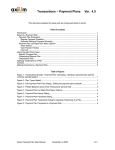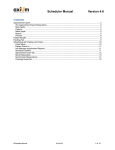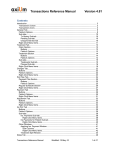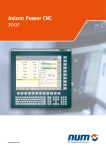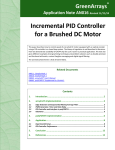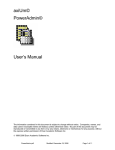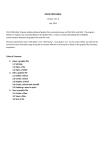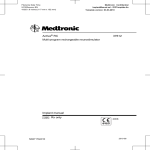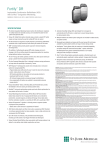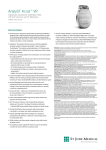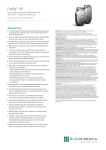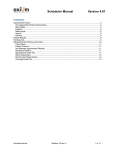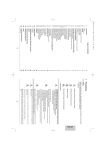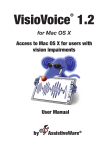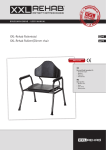Download patient brochure - The symptoms of chronic pain
Transcript
® Focus your therapy. Broaden your possibilities. I N T R O D U C T I O N T O S P I N A L C O R D S T I M U L AT I O N Table of Contents Introduction What is Spinal Cord Stimulation? What is Targeted Spinal Cord Stimulation? Intro to the Axium® Neurostimulation System Step 1: Trial Stimulation Step 2: Implantation of the Permanent System Frequently Asked Questions In tro d uc t i on t o Sp i n a l Co rd S ti m u l a ti o n Introduction Chronic pain affects almost one in five adults, impacting their ability to lead productive working, social and family lives. Chronic pain is defined as pain lasting longer than six months.1 Like you, most people experience months or even years of treatments without finding a suitable option. Chronic pain is a complex disease with different causes and symptoms. It is often difficult to identify the exact cause and treatment must be customized for each patient. You probably have had one or multiple treatments to relieve your pain symptoms. You might still use medication to treat your pain. At this time, your doctor recommends that you consider Spinal Cord Stimulation (SCS) therapy to treat your chronic pain. SCS is a well-established treatment for pain and has proven to be safe and effective, helping over 300,000 people in the last 40 years. The Spinal Modulation Axium® Neurostimulator System is a form of SCS that targets a neural structure branching off the spinal cord, called the Dorsal Root Ganglion (DRG). The Axium System does not cure chronic pain, but it can provide effective pain relief in addition to medications and other treatments. This booklet provides basic information about Spinal Cord Stimulation and the Spinal Modulation Axium Neurostimulator System. Your healthcare providers will gladly answer any of your questions about this treatment. 1. International Association for the Study of Pain (IASP) definition of chronic pain I ntroduction to Spina l Cord St imulat ion What is Spinal Cord Stimulation (SCS)? The sensation of pain is felt when your body sends a pain signal to your brain (Figure A). With chronic pain, that signal can continue even after the original problem is gone. All pain treatments try to stop the feeling of pain by blocking or weakening that signal before it reaches the brain. For example, drugs work by flooding your body with chemicals to try to mask the pain. Whether or not they succeed, drugs may have undesirable side effects because they are working all over your body. Spinal Cord Stimulation is a more precise way of treating pain. SCS uses a small implanted system, similar to a pacemaker. The system creates small electrical pulses that go to your spinal cord. These pulses replace the pain signal with a tingling or massaging feeling called paresthesia. This paresthesia covers the specific areas where you feel pain (Figure B). In tro d uc t i on t o Sp i n a l Co rd S ti m u l a ti o n PAIN SIGNALS TO THE BRAIN PAIN AREA Figure A: Pre-SCS stimulation What is Targeted Spinal Cord Stimulation? The Axium Neurostimulator System is a form of SCS that targets a neural structure branching off the spinal cord, called the Dorsal Root Ganglion (DRG). The DRG has been a target for physicians for pain relief for many years. The DRG can regulate pain signals before they enter the spinal cord and travel to the brain. The DRG acts like a traffic light and controls when sensations can enter the spinal cord. Targeted SCS stimulates the DRG and can create more red lights which may prevent pain signals from traveling to the brain. This provides a comfortable tingling or even an absence of pain. MASKED PAIN SIGNALS TO THE BRAIN PARESTHESIA COVERING THE PAIN AREA Figure B: Post-SCS stimulation I ntroduction to Spina l Cord St imulat ion With traditional SCS, leads are placed in the space behind the spinal cord, further from the nerves. With the Axium System, the special leads can be placed closer to the target (Figure C). This allows the system to focus the stimulation where it can help relieve your pain. The leads are stable and only small changes in stimulation may occur when you move between standing, sitting or lying down. Such movement can be a problem with traditional spinal cord stimulation.2 Clinical research has shown that DRG stimulation can treat pain in areas that have been hard to reach, such as the groin, lower leg, foot, and hand.3, 4, 5 2. Cameron, T. and Alo, K. M. (1998), Effects of Posture on Stimulation Parameters in Spinal Cord Stimulation. Neuromodulation: Technology at the Neural Interface, 1: 177–183. doi: 10.1111/j.1525-1403.1998.tb00014.x 3. S Schu, A Gulve, S ElDabe, G Baranidharan, K Wolf, W Demmel, D Rasche, M Sharma, D Klase, G Jahnichen, A Wahlstedt, H Nijhuis, L Liem. Spinal cord stimulation (SCS) of the dorsal root ganglion (DRG) for groin pain – a retrospective review. Pain Practice. 2014. ePub ahead of print. 4. J P Van Buyten, I Smet, L Liem, M Russo, F Huygen. Stimulation of dorsal root ganglia for the management of complex regional pain syndrome: a prospective case series. Pain Practice. 2014. ePub ahead of print. 5. Liem L, Demmel W, Schu S. Spinal cord stimulation (SCS) of the dorsal root ganglion (DRG) for chronic pain of the upper limbs – A multi-center case series. North American Neuromodulation Society, 16th Annual Meeting, Las Vegas, Dec 6-9, 2012. In tro d uc t i on t o Sp i n a l Co rd S ti m u l a ti o n Figure C: The Axium lead lies directly adjacent to the spinal cord Introduction to the Axium® Neurostimulator System Your Axium System consists of three components: NEUROSTIMULATOR: A pacemaker-sized device that sends out mild electrical pulses. Both stimulators contain a battery and electrical components. The Trial Neurostimulator (TNS) is used first and is worn on the outside of your clothing. The Implantable Neurostimulator (INS) replaces the TNS. It is implanted under the skin. Trial Neurostimulator (TNS) Implantable Neurostimulator (INS) Leads Programmer LEADS: Thin insulated wires which carry the pulses from the neurostimulator to the Dorsal Root Ganglion. The INS and leads are implanted inside your body. PROGRAMMER: A hand held “remote control” that lets you adjust the strength or the location of the stimulation and turn the stimulator on and off. I ntroduction to Spina l Cord St imulat ion Step 1: Trial Stimulation An important feature of Spinal Cord Stimulation is that you can try it first during a trial period. The temporary system works the same as an implanted system, so you can experience what spinal cord stimulation feels like, and how it works for you. If you decide to try the Axium System, you will start with a short, reversible surgical procedure. This will take one to two hours. You will stay in the hospital for approximately one day. In general, you will be awake during the procedure, so you can give feedback about the stimulation. You will be lying on your stomach. Using techniques similar to a spinal injection or nerve block, your physician will first implant the small, thin leads near your DRG. The leads will then be attached to an external trial stimulator that you will wear on your belt or keep in your pocket. Your physician or nurse will program different settings and ask you what feels best. The goal of this stimulation procedure is to cover the complete area of pain with a pleasant tingling feeling. This is an important time to give In tro d uc t i on t o Sp i n a l Co rd S ti m u l a ti o n feedback on how and where you are feeling the stimulation. After the procedure, you will be trained on how to use your wireless programmer. You will be able to adjust the therapy settings yourself using this programmer. You can also turn stimulation on or off. During the trial period, you and your physician will decide whether your Axium System is right for you. You will be able to slowly resume typical daily living with the following precautions. For the first six to eight weeks after implantation of leads, you should: • Limit physical activities that require lifting, bending or twisting of your back • Avoid raising your arms above your head • Not pull the extension lead coming out of the skin • Take care of your surgical sites as directed • Keep your trial stimulator dry and do not shower Step 2: Implantation of the Permanent System If the device fits your lifestyle and you are satisfied with the pain relief, you can choose to have the system permanently implanted. After the implant, you and your pain specialist will work together to program the best pain relief. You will still use the wireless patient programmer to control your therapy. A permanent implant procedure will be scheduled. Stimulation will be stopped ahead of the permanent procedure. The pain that was being treated may return to its original level. The permanent implant procedure is similar to the trial procedure. At the implant, the lead outside of your body will be removed. A pocket will be made just under your skin, usually in the abdomen or buttocks area. The leads will be connected and a new stimulator will be secured in the pocket. I ntroduction to Spina l Cord St imulat ion Frequently Asked Questions WHAT CAN I EXPECT WITH MY AXIUM NEUROSTIMULATOR SYSTEM? The Axium System does not cure or treat the cause of pain. However, it may improve your life by helping to manage your pain. The amount of relief provided by the system varies from patient to patient. Do not expect to be completely pain free. Yes. Spinal Cord Stimulation is a well-established therapy for chronic pain. For more than 40 years, SCS therapy has helped more than 300,000 patients. The Axium Neurostimulator System also has European approval (CE marking), indicating that this system is safe. If at any time you would like to have the system removed, the leads and stimulator can be taken out by your physician. HOW LONG WILL IT TAKE BEFORE I FEEL BETTER? Recovery times vary among patients. The stimulation therapy will work within the first week after leads are placed. The wounds from the lead implant will take one to two weeks to heal. The pain from the stimulator placement will decrease over a two-to-three month period. CAN I ACTUALLY CONTROL THE STIMULATION THERAPY? Yes. You will be given a programmer that allows you to adjust the settings on your stimulation device. Your nurse or a company representative will train you on how to use this programmer. You will be able to turn the therapy on and off, change the level of the stimulation and choose between different stimulation groups. . WHEN CAN I RESUME MY NORMAL ACTIVITIES? You should avoid bending, twisting, reaching, and picking up heavy objects for six to eight weeks. You should continue to avoid extreme activities after these six to eight weeks. Do not expect to be a pro football player or an Olympic athlete after the procedure. Make small goals for yourself and attempt to achieve these goals. IS TARGETED STIMULATION SAFE? In tro d uc t i on t o Sp i n a l Co rd S ti m u l a ti o n WILL THE IMPLANTED DEVICE BE VISIBLE? WILL I FEEL IT? This depends on your size, your build and the location of the stimulator. You most likely will feel the stimulator under your skin but in most cases it is not visible to others. IS IT SAFE TO USE HOUSEHOLD APPLIANCES OR CELL PHONES WITH THE STIMULATOR? Yes. It is safe to use microwaves, computers, cell phones and other general household appliances with your device. Security gates at stores or in airports may cause temporary changes in the level of your stimulation. While these will not damage your device, we recommend turning off your system as you pass through to ensure your comfort. This brochure provides only some of the safety information related to the Spinal Modulation Neurostimulator System. See the Patient Programmer User Manual for detailed disclosures, warnings, and precautions related to the system. Indications for Use—The Spinal Modulation Neurostimulator System is indicated for the management of chronic intractable pain. Contraindications—Patients contraindicated for the Spinal Modulation Neurostimulator System are those who: Have an active implantable medical device including but not limited to cardiac pacemakers and cardiac defibrillators; Are unable to operate the system; Are poor surgical risks; Are pregnant; Are under the age of 18. CAN I DRIVE MY CAR WITH MY STIMULATOR ON? No. Always turn the stimulator off when you are operating a motor vehicle or other heavy equipment. CAN I TRAVEL OR FLY WITH THE STIMULATOR? Yes. Air travel does not interfere with your system. Security gates in airports may cause temporary changes in the level of your stimulation. While this will not damage your device, we recommend turning off your system as you pass through to ensure your comfort. In many cases, you may be able to bypass the security gate if you identify that you are implanted with a stimulation system. You will be given a patient identification card after your implant. Show this card to the security officer before you enter a security gate and/or choose to bypass the security gate. Adverse Events—The implantation of a neurostimulation system involves risk. In addition to those risks commonly associated with surgery, the following risks are also associated with implantation and use of the Spinal Modulation Neurostimulator System: Pain (where the needle has been inserted); Pain (caused by understimulation due to lead migration); Pain over the implantable neurostimulator site; Escalating pain; Bleeding (where the needle has been inserted); Headache; Infection; Localized collection of serous (clear) fluid at injection site; Discomfort during the treatment; Allergic or rejection response to implant materials; Constant pain at the lead site; Stimulation of the chest wall; Lead migration (movement) and/or local skin breakage; Weakness; Clumsiness; Numbness; Temporary muscle activation. I ntroduction to Spina l Cord St imulat ion (MK0003E-en) Spinal Modulation is a global medical device company based in California, United States and Diegem, Belgium. For more information, visit www.spinalmodulation.com. MK0003E-EN AUG 2014 Spinal Modulation, Inc. 1135 O’Brien Drive Menlo Park, CA 94025 USA Spinal Modulation NV Airport Plaza Leonardo Da Vincilaan 19 1831 Diegem, Belgium Tel +32.2.719.04.44 Fax +32.2.400.42.39 Spinal Modulation Pty Ltd. Level 31 120 Collins Street Melbourne, Victoria 3000 Australia Tel +61.3.9225.5265 Fax +61.3.9225.5406 www.spinalmodulation.com.au












